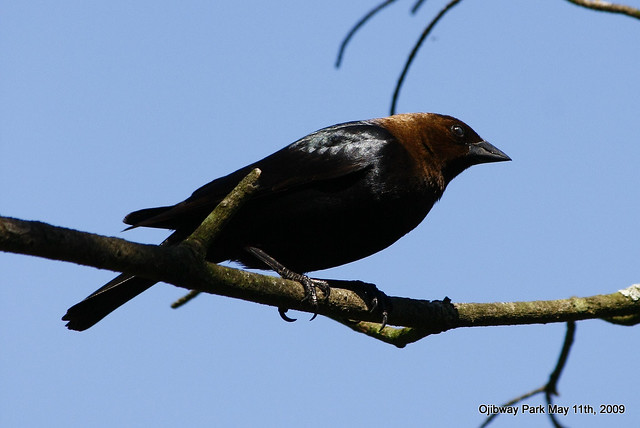I started this posting on the 12th of July and never got around to posting it until now. I really wanted to write a long discussion on the topic that got into urban sprawl, habitat fragmentation, and how our economic system demands that we grow our population.... But I'll just leave it as a posting about what the title says.
Three years ago when I started birding, I had photographed this bird (above) at the Ojibway feeder station. I didn't really know what the bird was but eventually identified it as a Brown Headed Blackbird. I came to find out that this is not a bird that birders like, due to its reproductive strategy. According to the Smithsonian National Zoological Park (SNZP): "A single female (cowbird) is capable of laying nearly one egg per day at the peak of the breeding season, and produces a total of 30-40 eggs over the 2-3 month breeding period (May-July). Because female cowbirds usually lay only one egg in a host nest, this translates into 30-40 nests parasitized (usually of at least several different species) per female in one season." (Petit)
SNZP continues to describe the parasitism strategy as follows: "Typically, female cowbirds find potential host nests by perching during early morning hours in a location with high visibility such as a dead tree in a forest opening, observing behavior of host females that are building nests, and following the unsuspecting birds directly to their nests. Once the nest location is known, the cowbird returns during the egg-laying period of the host female and deposits her own egg in the nest"(Petit).
 |
| Blue grey Gnatcatcher, in front of its nest |
So, a few days ago, I had noticed a very gregarious pair of Blue Grey Gnatcatchers as I was walking at Ojibway Park. I noticed them feeding their fledglings at their nest (see above). A few days later, I went back to observe the nest (from a safe distance of course) and was saddened to see a large brown bird perched on the tiny moss and lichen Blue-grey Gnatcatcher nest. Imagine how angry, confused and sad the parents are when they realize the fledgling they spent all of their energy on isn't even their own.
 |
| Large Cowbird Fledgling on a Blue-grey Gnatcatcher nest |
Pg 114 of Sibley's Guide to Bird Life and Bird Behavior has an excellent diagram that I wanted to put here but I want to respect the copyright restrictions of the books and may elaborate on the topic in a later blog posting.
How our economy grows & Urban Sprawl
Again, I lack the time to elaborate on this topic at present, but hopefully I can push it into an upcoming posting. I wanted to consider the idea that economic growth can come from two major sources: 1-Export Innovative products (such as Ipods and Windmills) and 2-grow the population. I also wanted to get into Dutch Disease, an economic term, not biological. Natural resource extraction in Canada, particularly the Alberta Tar Sands tend to increase the value of our currency, which hurts other sectors such as manufacturing. We've seen the Canadian dollar at parity with the US dollar for the last few years as well as an exodus of manufacturers from Ontario. I guess these ideas could be considered totally off topic, but I really wanted to tie in how this Brown headed Cowbird fledgling sitting on a Blue-grey Gnatcatcher nest is symbolic of our how we are affecting our ecosystems. Economics tells us that we will continue to fuel our system with more growth, more urban sprawl, more fragmentation and resource extraction, all things that will continue to hurt our ecosystems and give the Brown headed Cowbird the perfect conditions for it to thrive.
Good Birding,
Dwaynejava
Further Reading:
Petit Lisa, "Brown-headed Cowbirds: From Buffalo Birds to Modern Scourge", Smithsonian National Zoological Park, ND, WEB, July 12, 2012 , http://nationalzoo.si.edu/scbi/migratorybirds/fact_sheets/default.cfm?fxsht=3
Boesveld Sarah , "Efforts to curb urban sprawl not working - Jobs are following in the outward expansion of cities", Vancouver Sun, June 18, 2012, WEB, July 12, 2012, http://www.vancouversun.com/news/whoarewe/Efforts+curb+urban+sprawl+working+census+shows/6174917/story.html
Wikipedia, Habitat Fragmentation, http://en.wikipedia.org/wiki/Habitat_fragmentation
 |
| Cowbird and Upland Sandpiper in Glencoe Ontario. |








































